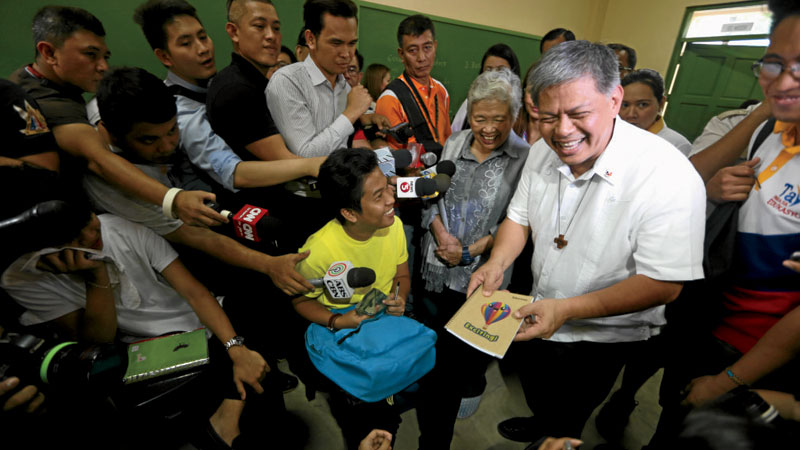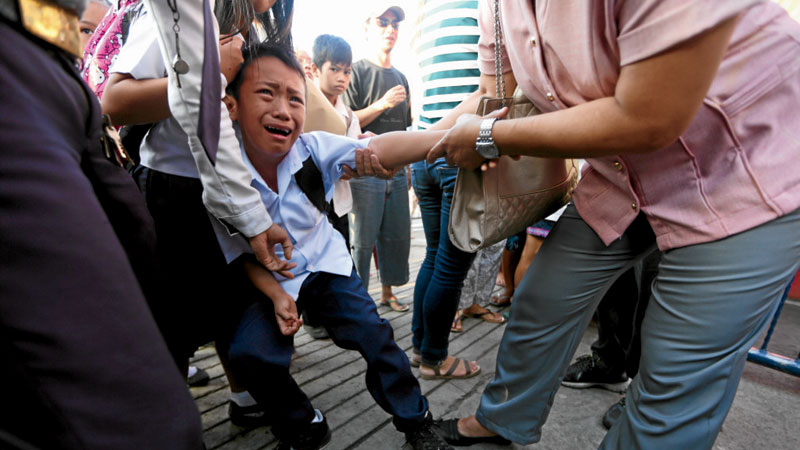Best school opening–Luistro

Education Secretary Armin Luistro and incoming Education Secretary Leonor Briones visit Commonwealth High School, Quezon City, June 13, 2016, during the opening of classes. INQUIRER PHOTO / NINO JESUS ORBETA
“THIS is the best school opening thus far.”
So declared Education Secretary Armin Luistro on Monday as the country welcomed its first batch of students under the senior high school (SHS) program, whose rollout marked the full implementation of the Aquino administration’s landmark K-12 education reform program.
Luistro acknowledged problems remained but that these were “solvable” and none were “insurmountable.”
Around 25 million public and private school students were welcomed back in over 46,700 public schools and around 12,000 private schools nationwide.
Of the 25 million students, 1.1 million formed part of the pioneer batch of the SHS program that was made available in over 11,000 private and public schools all over the country.
Article continues after this advertisementWhile the Department of Education (DepEd) hailed its own preparation for the school opening this year, the militant group League of Filipino Students (LFS) stressed that because of the introduction of the SHS program, it had “worsened the decade-old woes of our education system.”
Article continues after this advertisementLFS national spokesperson JP Rosos pointed out that his group had received reports of low enrollment in at least four public high schools in the capital: Tondo High School (THS), E. Rodriguez Jr. High School (ERJHS), Paez High School (PHS) and Batasan National High School (BNHS).
Open areas
Rosos said that in THS, only 89 students enrolled for senior high school out of its 300 Grade 10 completers. He claimed that these students held their classes in “open areas” because of the shortage of classrooms.
In ERJHS, he said that only a third of the expected 600 SHS students enrolled, while at PHS only 300 of its 500 Grade 10 completers reported to the school.
BNHS principal Diego Amid said that of the over 2,600 Grade 10 completers, only 89 joined its SHS program despite its absorptive capacity of 670 students.
He added that the SHS students were occupying ancillary rooms at the school as the four-story 12-classroom building dedicated for their SHS program was still under construction.
During his joint press briefing with incoming Education Secretary Leonor Briones at Commonwealth High School, Luistro said that the low number of enrollees, particularly at BNHS, was due to the historical trend of students transferring to private institutions after finishing fourth year high school (now Grade 10).
“Not all high school graduates would enroll in the same school. In Batasan, I believe many enrolled in other schools. Historical data in the NCR (National Capital Region) also shows that 60 percent [of public school graduates] go to private schools, while 40 percent go to state universities,” he said.
Financial burden
Rosos, however, belied Luistro’s assessment.
“Students did not enroll in public senior high schools not because they are capable to go to private schools. They drop out of schooling because of the additional financial burden that the additional two years entail,” Rosos said in a statement on Monday.
In Pasig City’s Rizal High School (RHS), the turnout of SHS enrollees was more promising.
School principal Virginia Membrebe said that of their 2,000 Grade 10 completers, 1,650 enrolled in the SHS program’s four tracks offered in the school, namely, academic, sports, arts and design, and technical-vocational livelihood.
Membrebe said that the students, however, were temporarily housed in the junior high school building as they awaited the completion of a six-story and two four-story buildings for the SHS program.
Because of this, students from the lower years, numbering around 9,000, will be undergoing two shifts.

SCHOOL OPENING BLUES Jaylord Mabanta cries at the gate of President Corazon Aquino Elementary School in Batasan Hills, Quezon City, during the opening of classes. NIÑO JESUS ORBETA
Ponciano Menguito, DepEd director for Metro Manila, said that the two shifts at RHS would last only till October. He noted that in the metro, over the last decade, the DepEd has improved its class shifts, with only 76 percent of the schools offering two shifts and the rest offering single shifts.
As of writing, 600,000 students for the SHS program has been recorded in the DepEd’s pioneer online enrollment system.
Luistro said that the Deped was expecting at most 800,000 students in the public schools and another 300,000 from private schools.
He noted that there was a slow encoding of data because some public schools were in hard-to-reach areas.
As for the delivery of learner modules, Luistro said that it was currently ongoing and that if a school had yet to receive its hard copy, the school administration had the funds to produce copies of the materials. With a report from Evelyn Cruz